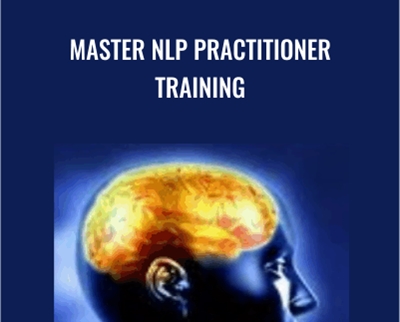Buy Master NLP Practitioner Training – inlpcenter.org Course at GBesy. We actively participate in Groupbuys and are committed to sharing knowledge with a wider audience. Rest assured, the quality of our courses matches that of the original sale page. If you prefer, you can also buy directly from the sale page at the full price (the SALEPAGE link is directly provided in the post).
Salepage link: At HERE. Archive: https://archive.is/wip/JO7Fm
$497 $58 – Master NLP Practitioner Training – inlpcenter.org
The iNLP Center’s NLP Master Practitioner Training is different.
Many NLP training centers offer an NLP master practitioner training that is just more of the practitioner material, with little fundamentally new material. They merely teach a greater variety of techniques. Rather than teach you more of the same, iNLP takes you to entirely new levels of understanding. Our NLP master practitioner training offers unique models of human development and communication that put NLP techniques in a useful context; methods that are not based on NLP practitioner level material.
For example, the VAK model is fundamental to NLP practitioner basic training. At the practitioner level, you learn the VAK model and several practices that flow from it. So, when you move on to the NLP Master Practitioner training, what do you learn? Even more techniques and practices that flow from the VAK model!
The VAK model is wonderful and well worth your time to learn well. However, once you know VAK basics and the several processes that are taught in NLP practitioner training, you can expand your repertoire of VAK techniques by simply reading about them. You don’t need to pay someone to teach you yet another variation of what you already know.
(Our NLP Master Practitioner Training is an advanced NLP training, to be taken after completing our NLP Practitioner Certification. You can also enroll in both at the same time for a significant discount, this is referred to as our NLP Combo Training.)
NLP Master Practitioner Modules:
View breakdown of this module
Module 1 Psychological Levels of Development
- Know where you are and what you need to do as an adult interested in growth
- Understand what to help people with and when
- Be able to address your own and clients’ deepest psychological needs
- Understand why so many interventions fail
- Unit 1 Introduction to Psychological Levels of Development
- Unit 2 Levels Overview
- Unit 3 NLP and Developmental Theory
- Unit 4 What We Learn from Developmental Theory
- Unit 5 • Psyche Builder: Levels of Development
- Unit 6 • Coaching Exercise: Levels of Development
Module 1: Psychological Levels of Development
- Know where you are and what you need to do as an adult interested in growth
- Understand what to help people with and when
- Be able to address your own and clients’ deepest psychological needs
- Understand why so many interventions fail
It’s easy to understand that a small child of five years of age does not possess the same knowledge, skills and awareness that a mature adult of 50 has. Between five and 50 are years of learning and experience for which there is no substitute. To achieve a similar degree of development as a mature adult, there seems to be no choice but for the child to go through a similar number of years, adding to his experience and awareness along the way.
Any methodology intended to help people would benefit from this kind of developmental understanding of the process of maturation. In the world of psychology, many authors and researchers have written on this subject. iNLP has taken the work of the foremost developmental theorists and synthesized it into a model that we teach in our public trainings and use in our private work with people.
We believe that understanding where someone is in the larger course of their life sheds light on how to work with them. This includes knowing which goals to set, which techniques to use and what results to expect.
Module 2 The Physiology Map
- Know specifically what you need to do to get unstuck
- Develop strategies to achieve positive emotional states
- Understand where conventional wisdom fails to create lasting emotional flexibility
- Unit 1 Introduction to The Physiology Map
- Unit 2 Understanding the Quadrants
- Unit 3 Rules and Characteristics
- Unit 4 Implications of The Physiology Map
- Unit 5 Additional Map Understanding
- Unit 6 Map Activities
- Unit 7 • Psyche Builder: The Physiology Map
- Unit 8 • Coaching Exercise: The Physiology Map
Module 2: The Physiology Map
- Know specifically what you need to do to get unstuck
- Develop strategies to achieve positive emotional states
- Understand where conventional wisdom fails to create lasting emotional flexibility
The Physiology Map is a model developed by NLP Santa Fe and the iNLP Center. The Physiology Map tracks emotions, or physiological states, which we consider to be one and the same. Each physiological state we experience has certain qualities or characteristics.
We attempt classify those characteristics with this model. The Physiology map implement the concepts of Associaltive/Dissociative and External/Internal as a way to map ones emotional state into quadrants. When we understand the Physiology Map and it’s implications for human behavior, it becomes clear for us how to use this NLP model to help people, and ourselves, move in useful directions.
Module 3 The Twelve States of Attention
- Radically increased visual, auditory and kinesthetic flexibility
- Ability to access VAK places where it is impossible to get stuck
- Unit 1 Introduction to The Twelve States of Attention
- Unit 2 Model Overview
- Unit 3 Twelve States Sense Experiments
- Unit 4 • Psyche Builder: States of Attention
- Unit 5 • Psyche Builder 2: States of Attention
Module 3: The Twelve States of Attention
- Radically increased visual, auditory and kinesthetic flexibility
- Ability to access VAK places where it is impossible to get stuck
As you know, within NLP there is great emphasis on three of our sensory systems: visual, auditory, and kinesthetic (seeing, hearing and feeling). Each system is known as a modality. Using traditional NLP we go beyond analyzing what we are thinking or experiencing by learning how our thoughts and experience are structured in our brain. Understanding this structure and how to influence it gives us monumental advantages.
Beyond seeing, hearing and feeling, we can make two other essential sensory distinctions (and we are not referring to olfactory/smell or gustatory/ taste). The broad-narrow and internal-external sensory distinctions add a new level of sophistication to the VAK model.
These two additional sensory distinctions are probably more important to our psychological functioning than seeing, hearing and feeling alone.
Module 4 The Quad Map
- More control of your mind and attention
- Ability to get unstuck quickly
- Get to a positive mental outcome efficiently, regardless of the starting point
- Unit 1 Introduction to the Quad Map
- Unit 2 The Quad Map Structures
- Unit 3 Coaching Applications
- Unit 4 Map Activity 1
- Unit 5 Map Activity 2
- Unit 6 • Psyche Builder: The Quad Map
- Unit 7 • Coaching Exercise: The Quad Map
Module 4: The Quad Map
- More control of your mind and attention
- Ability to get unstuck quickly
- Get to a positive mental outcome efficiently, regardless of the starting point
Our minds are constantly in motion, remembering past experiences and imagining future experiences. It is interesting how little time we spend in the present, in this moment, with our attention directed fully toward the external world. So often we are inside our mind, attending to inner life. So much of our experience, both positive and negative, is influenced by how we direct our attention.
What if we knew just how to direct people’s attention to the most helpful place? Imagine a child coming to you, describing how hurt she feels because her friends have betrayed her. There is a way to ask a question or make a comment to that child that will drive her further into her pain. And there is a way to give her hope. Which do you want to do?
Imagine your boss coming to you, complaining about your work progress over the last month. When you have a chance to respond, you have the option of directing him in a direction that will further convince him of his position, or open his mind toward a more positive outlook. Which do you want to do?
The questions we ask and the comments we make invite others to direct their minds in ways that will be helpful, productive and positive, or not. Understanding the Quad Map gives us a significant advantage when we communicate with others.
Module 5 Criteria for Psychological Safety
- Feel safer every day
- Enhanced confidence and motivation
- Clearer decision making and prioritizing
- Unit 1 Introduction to Psychological Safety Zones
- Unit 2 Personality Traits
- Unit 3 Creating a Psychological Safety Zone
- Unit 4 Discovering your Psychological Safety Zone Criteria
- Unit 5 • Psyche Builder: Psychological Safety Criteria Analysis
- Unit 6 • Coaching Exercise: Exercise: Discovering Psychological Safety Criteria
Module 5: Criteria for Psychological Safety
- Feel safer every day
- Enhanced confidence and motivation
- Clearer decision making and prioritizing
Emotional safety is primal. If we do not find a way to feel safe each and every day, we cannot accomplish much beyond reacting to the vague yet constant threat. Most of our life is geared towards reducing anxiety and getting to a place where we feel safe.
Worse, often we put ourselves in threatening situations in the name of personal growth. Too many personal growth advocates push people to break far out of their comfort zone. Expand beyond your limits, destroy obstacles and succeed beyond your wildest expectations! This is a terrible set up that is destined to fail.
Suddenly expanding beyond perceived limitations, which are psychological protections, brings with it fear of the unknown that sends the primitive brain into a tailspin. If it were possible to suddenly destroy your every psychological defense mechanism and wildly expand your boundaries to include all sorts of unfamiliar experiences, you’d experience an incredible rush of panic.
A quest for inner peace, as well as personal development, should honor the need for emotional safety. You are wired for personal safety and your personal development plan needs to be equally wired! If not, you are picking a fight with your primitive brain. This is a fight you will lose.
Module 6 Metaphoric Intervention
- Align yourself with the most meaningful and powerful way for you to view life
- Discover your personal metaphor
- Create new lenses to view areas of your life
- Unit 1 What are Metaphors?
- Unit 2 How Metaphors Affect our Lives
- Unit 3 A Life Straightening Out
- Unit 4 Example Metaphors
- Unit 5 Your Metaphoric Perspective
- Unit 6 Physical Metaphors
- Unit 7 Identifying Your Current Life Metaphor
- Unit 8 Adopting a New Life Metaphor
- Unit 9 My New Life Metaphor
- Unit 10 Integrating Your New Life Metaphor
- Unit 11 • Psyche Builder: Life Metaphor
- Unit 12 • Coaching Exercise: Metaphoric Intervention
Module 6: Metaphoric Intervention
- Align yourself with the most meaningful and powerful way for you to view life
- Discover your personal metaphor
- Create new lenses to view areas of your life
Our concept of existence is metaphorical in nature. We can only comprehend life, objects and ourselves by association, which is the broad meaning of metaphor – to understand one thing in terms of another. The earth is a tiny ball floating through space. Associating the earth with a floating ball helps us put things in a context that fosters understanding. Here are some other examples:
The brain is like a computer; Life is a test; College is like a 24/7 party; Time is money ; Argument is war
The metaphor we choose or inherit, often deeply unconscious, holds tremendous power over how we feel, think, behave and interact with other people.
This module will help you discover your personal life metaphor and show you how to change it, if necessary, to something deeply empowering.
Module 7 Core Transformation
- Deep self-acceptance
- Tame the angry, rebellious, hidden or outcast parts of yourself
- Experience your core state for perhaps the first time
- Unit 1 Permissions
- Unit 2 Introduction to Core Transformation
- Unit 3 Outcome Chains
- Unit 4 Video Prep
- Unit 5 CT Prep Questions
- Unit 6 Core Transformation Step 1
- Unit 7 Core Transformation Step 2
- Unit 8 Core Transformation Step 3
- Unit 9 Core Transformation Step 4
- Unit 10 Core Transformation Step 5
- Unit 11 Core Transformation Optional Steps
- Unit 12 Additional CT Demonstrations
- Unit 13 • Psyche Builder: Core Transformation
- Unit 14 • Coaching Exercise: Core Transformation
Module 7: Core Transformation
- Deep self-acceptance
- Tame the angry, rebellious, hidden or outcast parts of yourself
- Experience your core state for perhaps the first time
The Core Transformation method is one of the deepest and most sophisticated processes in the field of NLP. The method was developed by Connie Rae Andreas, who has given the iNLP Center permission to teach it.
The goal of Core Transformation is to help one reach their core state, which is a state of wholeness, oneness, peace or connection to the universe. As you work your way up and down the steps, one will see their ability to access their core state at any moment. Every step of the process leads toward that state of wholeness.
In this module, we break down the steps. The video demonstration show each part of the process so you will be able to replicate it with a client. The exercises featured in this module allow you to try it with a friend and work on yourself as well.
Module 8 The Default Mode Network
- Dramatic and immediate stress reduction
- Mindfulness tool to live in the moment
- Experience more clarity around difficult stressors
- Unit 1 Introduction to the DMN
- Unit 2 Origins of Stress
- Unit 3 Managing the DMN
- Unit 4 Intentional Use of the Senses
- Unit 5 NLP Sense Experiments
- Unit 6 NLP Mind Cleanse Step 1
- Unit 7 NLP Mind Cleanse Step 2
- Unit 8 NLP Mind Cleanse Step 3
- Unit 9 NLP Whole Mind Integration Activity
- Unit 10 Integrated Living & Anchored States
- Unit 11 Personas
- Unit 12 The New Response
- Unit 13 • Psyche Builder: The Default Mode Network
Module 8: The Default Mode Network
- Dramatic and immediate stress reduction
- Mindfulness tool to live in the moment
- Experience more clarity around difficult stressors
Sometimes it may seem like there is a little demon living inside your brain making you feel tense and miserable. Well, there is! Your brain has an internal network, the Default Mode Network (DMN) that, when active, continually generates an ocean of mental activity and body tension. The DMN never, ever stops churning unless you are purposefully engaged in a particular kind of cognitive task. When your task-oriented mind is resting, the DMN is working overtime. This is a proven, scientific fact that has been validated via fMRI scans (see references).
When the DMN is overactive, common in today’s world, it is like a digital clock that blinks the word “stress” incessantly. You move throughout your day on autopilot, with churning, grinding thoughts and body tension ruling your awareness. Your stress and preoccupation get in the way of dealing with others, getting work done and even sleeping.
Module 9 Meta Programs
- Understand key drivers of human behavior
- Become better at influencing others with integrity
- Unit 1 Introduction to Meta Programs
- Unit 2 Meta Programs Considerations
- Unit 3 Motivation Toward/Away
- Unit 4 Internal/External Validation
- Unit 5 Proactive/Responsive
- Unit 6 Vague/Specific
- Unit 7 Self/Other Motivation
- Unit 8 • Stealth Mission: Meta Programs
- Unit 9 • Psyche Builder: Meta Programs
Module 9: Meta Programs
- Understand key drivers of human behavior
- Become better at influencing others with integrity
In NLP, meta programs are information filters. They are mental sorting devices that determine which information to keep, which to ignore, which to act upon and how to act upon it.
Meta programs guide decisions and behaviors. Some meta programs are so powerful that they can almost seem like personality traits. They’re not, though. They are simple filters that guide us through a world of information. Most often, meta programs are deeply unconscious. They do their work under the surface and are only rarely discovered by people (who are typically studying NLP).
When you understand key meta-programs, you gain an unusually powerful insight into human behavior, decision-making, motivation, communication styles and more.
Module 10 Presuppositions
- Understand the limited assumptions others make and turn them into breakthroughs
- Tailor your communication to empower others
- Unit 1 Introduction to Presuppositions
- Unit 2 Basic Presuppositions
- Unit 3 Challenging Presuppositions
- Unit 4 Reversing Presuppositions
- Unit 5 • Stealth Mission: Reversing Presuppositions
- Unit 6 Creating Presuppositions
- Unit 7 • Psyche Builder: Presuppositions
Module 10: Presuppositions
- Understand the limited assumptions others make and turn them into breakthroughs
- Tailor your communication to empower others
Presuppositions are the linguistic equivalent of what most people call assumptions. Presuppositions refer to what must already be assumed to be true for the question or statement to make sense.
Presuppositions are typically not stated directly. The are hidden assumptions in conversation.
Every sentence we speak in our everyday life has presuppositions in it. In the majority of cases we tend not to consciously recognize what we have presupposed, and concentrate on what is directly stated.
Therefore, presuppositions are unconsciously accepted as being true. This often has a direct impact upon behavior, whether or not the assumption is accurate.
Module 11 Logical Levels
- Help people in the most efficient, effective way and with the highest amount of leverage
- Know where to intervene and what tools to use
- Create a path forward focused on the areas of need
- Unit 1 Introduction to Logical Levels
- Unit 2 Logical Levels Categories
- Unit 3 Logical Levels Example 1
- Unit 4 Logical Level Example 2
- Unit 5 • Psyche Builder: Logical Levels
- Unit 6 • Coaching Exercise: Logical Levels
Module 11: Logical Levels
- Help people in the most efficient, effective way and with the highest amount of leverage
- Know where to intervene and what tools to use
- Create a path forward focused on the areas of need
The classic logical levels model, as introduced by Gregory Bateson, has long served as a guide for practitioners to know how to intervene. In this module, you will learn the nuts and bolts of Logical Levels. It will answer questions that you never thought to ask, such as:
Why are some behaviors so hard to change, and what can you do about it?
Where is the most efficient and effective place to intervene when someone presents a problem?
Where is the highest leverage place to intervene?
Module 12 Module Integration
- This final module combined what you have learned in this course and asks you a series of questions based on your desired outcome.
- Unit 1 • Outcome Integration
- Unit 2 • Session Demonstration
Module 12: Module Integration
This module helps you integrate the learning from all prior modules, developing a road map toward a specific, large chunk goal in your future.
You’ll apply everything you’ve learn thus far in the training to this goal, dramatically increasing your chances for success and ensuring that the next period of your life will be filled with personal growth and personal empowerment.
You will also record a NLP session with a volunteer and submit to demonstrate your Master NLP skills.
$497 $58 – Master NLP Practitioner Training – inlpcenter.org
Buy the Master NLP Practitioner Training – inlpcenter.org course at the best price at GBesy.. After your purchase, you will get access to the downloads page. You can download all the files associated in your order at here and we will also send a download notification email via your mail.
Unlock your full potential with Master NLP Practitioner Training – inlpcenter.org courses. our courses are designed to help you excel.
Why wait? Take the first step towards greatness by purchasing Master NLP Practitioner Training – inlpcenter.org courses today. We offer a seamless and secure purchasing experience, ensuring your peace of mind. With our trusted payment gateways, Stripe and PayPal, you can confidently complete your transaction knowing that your financial information is protected.
Stripe, known for its robust security measures, provides a safe and reliable payment process. With its encrypted technology, your sensitive data remains confidential throughout the transaction. Rest assured that your purchase is protected.
PayPal, a globally recognized payment platform, offers an additional layer of security. With its buyer protection program, you can feel confident in your purchase. PayPal ensures that your financial details are safeguarded, allowing you to focus on your learning journey.
Is it secure? to Use of?
- Your identity is completely confidential. We do not share your information with anyone. So it is absolutely safe to buy the Master NLP Practitioner Training – inlpcenter.org course.
- 100% Safe Checkout Privateness coverage
- Communication and encryption of sensitive knowledge
- All card numbers are encrypted using AES at relaxation-256 and transmitting card numbers runs in a separate internet hosting atmosphere, and doesn’t share or save any data.
How can this course be delivered?
- After your successful payment this “Master NLP Practitioner Training – inlpcenter.org course”, Most of the products will come to you immediately. But for some products were posted for offer. Please wait for our response, it might take a few hours due to the time zone difference.
- If this happens, please wait. The technical department will process the link shortly after. You will receive notifications directly by e-mail. We appreciate your wait.
What Shipping Methods Are Available?
- You will receive a download link in the invoice or YOUR ACCOUNT.
- The course link always exists. use your account to login and download the Master NLP Practitioner Training – inlpcenter.org course whenever you need.
- You only need to visit a single link, and you can get all the Master NLP Practitioner Training – inlpcenter.org course content at once.
- You can do your learning online. You can be downloaded for better results and can study anywhere on any device. Make sure your system does not sleep during the download.
How Do I Track Order?
- We always notice the status of your order immediately after your payment. After 7 days if there is no download link, the system will automatically complete your money.
- We love to hear from you. Please don’t hesitate to email us with any comments, questions and suggestions.
![GBesy [GB] GBesy [GB]](https://www.gbesy.com/wp-content/uploads/2023/05/gbesy-Logo-full-100.png)

![[Audio] BT12 Conversation Hour 11 - 1956 Flashback: Hypnosis](https://www.gbesy.com/wp-content/uploads/2023/07/Audio-Only-BT12-Conversation-Hour-11-1956-Flashback-Hypnosis-Paradox-Metaphorical-Tasks-The-Invention-of-Brief-Couples-Therapy-Wendel-Ray-PhD.png)

 Purchase this course you will earn
Purchase this course you will earn 





Reviews
There are no reviews yet.